Celebrating 20 Years of Smashing Success at RHIC
A look back at the early days, after two decades of discovery at the Relativistic Heavy Ion Collider
June 12, 2020
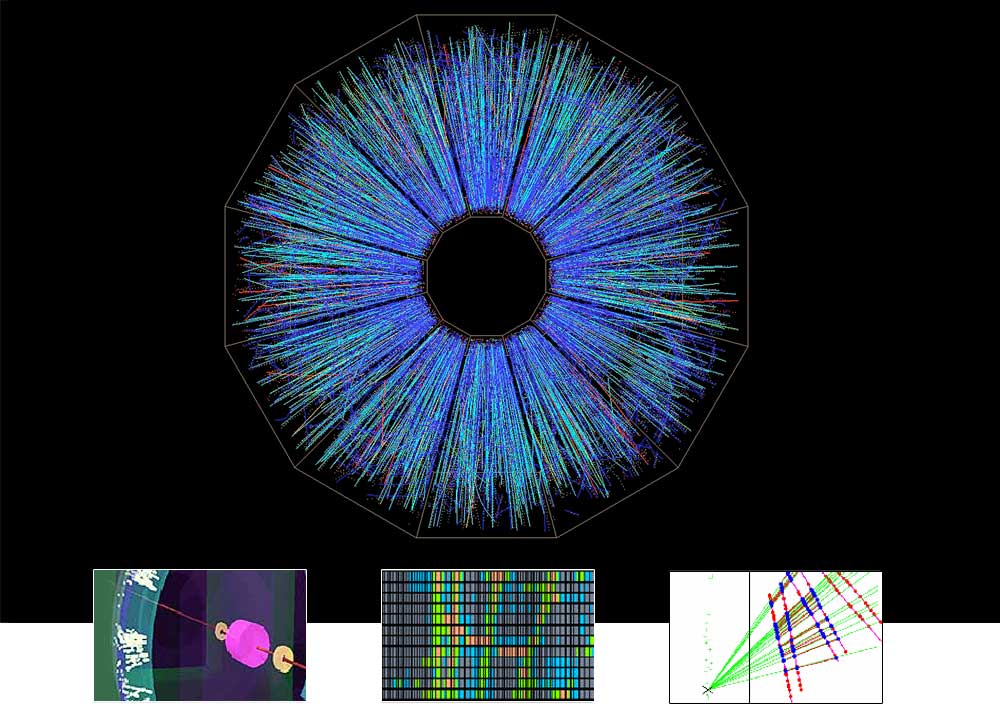
Images showing the tracks of thousands of subatomic particles streaming from collisions at the Relativistic Heavy Ion Collider (RHIC) lit up display monitors at the STAR detector for the first time on June 12, 2000. All four RHIC detector were recording collisions by Friday, June 15 (insets left to right: PHENIX, BRAHMS, PHOBOS).
Even in a time before Instagram, physicists starting up the Relativistic Heavy Ion Collider (RHIC)—a particle collider at the U.S. Department of Energy’s Brookhaven National Laboratory—knew they needed a great picture to share their success. They and the rest of the world were not disappointed. Around 9 p.m. on June 12, 2000—20 years ago today—subatomic “fireworks” lit up display monitors in the control room of RHIC’s STAR detector as gold ions (atomic nuclei stripped of their electrons) smashed into one another at nearly the speed of light. These images, capturing the tracks of thousands of subatomic particles streaming from dramatic head-on particle smashups—soon joined by complementary data snapshots from the PHOBOS, PHENIX, and BRAHMS detectors—appeared in newspapers and on websites around the world, declaring the start of a new era in nuclear physics.
Over the past 20 years, RHIC’s nuclear physics program has been a smashing success. With collisions routinely recreating the conditions of the early universe and exploring unprecedented aspects of the colliding particles’ properties, RHIC has made surprising discoveries and opened new areas of inquiry about nuclear matter—including the “perfect” liquid nature of the quark-gluon plasma and the sources of proton spin. Upgrades to detectors and a series of “world’s first” accelerator advances have pushed the capabilities of this DOE Office of Science user facility for nuclear physics research well beyond the expectations foreseen at its opening. And now, with two decades of record-breaking accomplishments under its belt, RHIC is poised to dive deeper into the fundamental structure of nuclear matter with a final set of measurements to close out its experimental program. Then, a major collaborative effort will transform some of RHIC’s foundational components into a brand-new nuclear physics research facility—an Electron-Ion Collider (EIC) that will take physicists into the next frontier.
But before we begin that next journey, let’s wind back the clock and take a look at the lead-up to RHIC’s first collisions with these excerpts from the Brookhaven Bulletin. As you’ll see, getting a complicated particle collider up and running takes a lot of teamwork and coordinated effort. And it isn’t always a straight-line path!
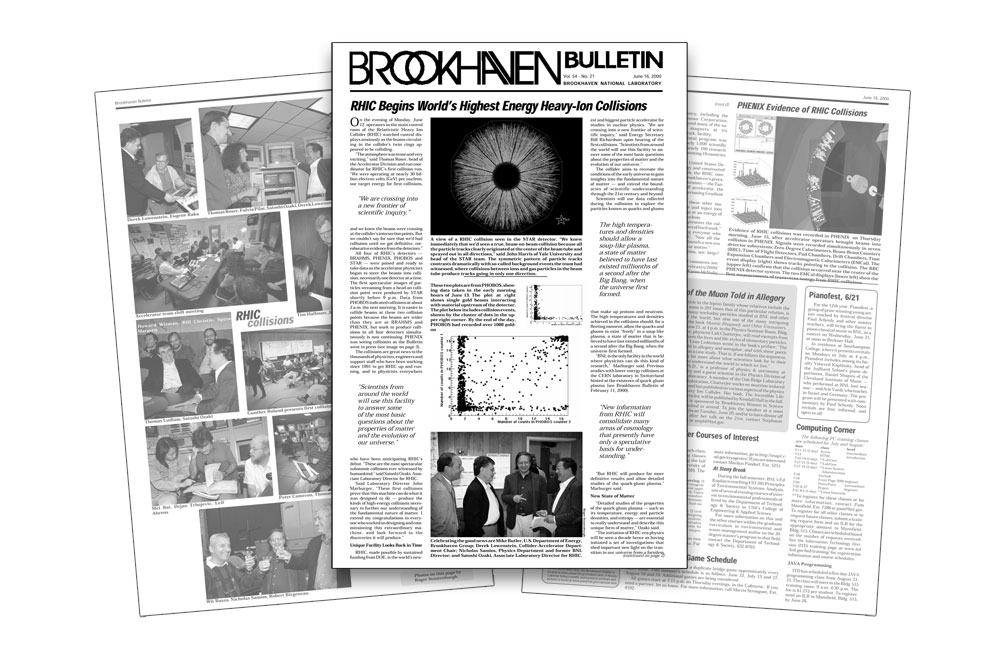
The Brookhaven Bulletin announces the successful start of RHIC collisions.
January 28, 2000 • RHIC Computing Facility Ramps Up
As the time approaches for the Relativistic Heavy Ion Collider (RHIC) experiments to start “Day One” physics, the RHIC Computing Facility (RCF) is also ramping up toward its production levels…The RCF is designed to archive, reconstruct, and analyze the immense amount of data to be produced by the RHIC complex. At RHIC, where two accelerated beams of gold ions will cross and collide, tens of thousands of particles will emerge to be measured or tracked by four experiments, BRAHMS, PHENIX, PHOBOS, and STAR. The data from these collisions will stream at approximately 60 Megabytes per second over a dedicated fiber optic link from the RHIC ring to the Information Technology Division (ITD) data centers.
February 4, 2000 • East Arm of PHENIX Inches Into Place
On January 21, after several days of inch-per-minute movement, the “east arm” of the massive PHENIX detector for BNL’s Relativistic Heavy Ion Collider (RHIC) was finally put in place. The event capped an all-out effort to finish the detector’s assembly in time for…RHIC start-up.
February 11, 2000 • At CERN, Quark-Gluon Plasma?
CERN, the European laboratory for particle physics, located in Switzerland, has just made public the results of its five-year program of heavy-ion collision experiments, hinting at the formation of a quark-gluon plasma. This state of matter, thought to have existed just microseconds after the “Big Bang,” is the same elusive quarry sought by experiments due to begin soon at BNL’s Relativistic Heavy Ion Collider (RHIC). Has CERN scooped RHIC? The answer is no. CERN stated that their evidence is indirect and “circumstantial.” But their results do generate great confidence that the quark-gluon plasma may be directly observed for the first time when RHIC achieves full operational status.
March 17, 2000 • Update on RHIC
Cool-down of RHIC’s magnets and testing of power supplies is well underway. RHIC’s Blue Ring [one of two rings made of superconducting magnets] is expected to be cooled to its operating temperature of 4 Kelvin by March 20. The Yellow Ring will follow on March 31. Power supply testing will continue into early April. “So it will be a few more weeks before beams begin circulating,” said Waldo MacKay, [then] head of machine operations for the Collider-Accelerator Department [now retired].
April 14, 2000 • RHIC Blue Ring Circulates, Yellow On Deck
On April 2, the RHIC team began injecting gold ions into the Blue Ring. So far, the beam has circulated at injection energy for up to 20 minutes. That’s the equivalent of nearly 100 million laps around the ring for each bunch of gold ions…The team is now working on setup of the radio-frequency (RF) system and extending the lifetime of the beam, to get it ready to accelerate to the energy needed for collisions.
May 26, 2000 • Circulating Beam
“It’s like learning to drive at the Indy 500.” That’s how Derek Lowenstein, [then] Chairman of the Collider-Accelerator Department [now retired], described ongoing attempts to get beams of gold ions circulating for extended lifetimes in the two rings of the Relativistic Heavy Ion Collider (RHIC). The RHIC team has been working around the clock to steer beams around the twin tracks of the accelerator and ramp them up for the machine’s first heavy ion collisions….There has been significant progress, despite a few unforeseen obstacles, …[including] a problem [that] developed in the power lead to one of the superconducting corrector magnets in RHIC’s blue ring. To fix this, one-sixth of both the blue and yellow rings needed to be warmed up to room temperature. After the repair was successfully completed and the rings were cooled again, commissioning with beam resumed on April 28. On May 7, beam was successfully circulated in the yellow ring. “We now have gold beam that survives long enough at injection energy to fill both rings and start accelerating beams to higher energies,” said Thomas Roser, [then] head of the Accelerator Division [now Collider-Accelerator Department Chair].
June 9, 2000 • RHIC Commissioning: The Gold Rush Toward Collision
These are exciting times for accelerator physicists…“It’s a very high-energy environment,” [said accelerator physicist Fulvia Pilat, then one of seven shift leaders in the RHIC control room, now at Oak Ridge National Laboratory]. “At times it seems like you hit your head into the wall trying to solve some problem, and then you get a breakthrough and make a great leap.” At press time, the RHIC commissioning team had succeeded in circulating beam simultaneously in both rings to 66 billion electron volts (GeV), the target energy for first collisions. They are now fine tuning the alignment of the beams so they will collide head-on at [four of] the six intersection points. First collisions could come at any time.
June 16, 2000 • RHIC Begins World’s Highest Energy Heavy-Ion Collisions
On the evening of Monday, June 12, operators in the main control room of the Relativistic Heavy Ion Collider (RHIC) watched control displays anxiously as the beams circulating in the collider’s twin rings appeared to be colliding. “The atmosphere was tense and very exciting,” said Thomas Roser, [then] head of the Accelerator Division and run coordinator for RHIC’s first collision run [now Collider-Accelerator Department Chair]. “We were operating at nearly 30 billion electron volts (GeV) per nucleon, our target energy for first collisions, and we knew the beams were crossing at the collider’s intersection points. But we couldn’t say for sure that we’d had collisions until we got definitive, corroborative evidence from the detectors.”
All four of RHIC’s detectors — BRAHMS, PHENIX, PHOBOS and STAR — were poised and ready to take data as the accelerator physicists began to steer the beams into collision, necessarily one detector at a time. The first spectacular images of particles streaming from a head-on collision point were produced by STAR shortly before 9 p.m. Data from PHOBOS indicated collisions at about 2 a.m. the next morning…PHENIX was seeing collisions as the Bulletin went to press. [The first glimpse of collisions at BRAHMS was detected on June 15 at around 11 p.m., just after this edition of the Bulletin was printed.]
The collisions are great news to the thousands of physicists, engineers and support staff … working since 1991 to get RHIC [built and] up and running, and to physicists everywhere who have been anticipating RHIC’s debut. “These are the most spectacular subatomic collisions ever witnessed by humankind,” said Satoshi Ozaki, [then] Associate Laboratory Director for RHIC [now deceased].
Said [then] Laboratory Director John Marburger, “These first collisions prove that this machine can do what it was designed to do — produce the kinds of high-energy collisions necessary to further our understanding of the fundamental nature of matter. I extend my congratulations to everyone who worked on designing and commissioning this extraordinary machine, and look forward to the discoveries it will produce.”
“Detailed studies of the properties of the quark-gluon plasma — such as its temperature, energy and particle densities, and entropy — are essential to really understand and describe this unique form of matter,” Ozaki said.
“The initiation of RHIC-era physics will be seen a decade hence as having initiated a set of investigations that shed important new light on the transition in our universe from a formless plasma of hot quarks and gluons to the dazzling diversity of matter that we see today, including ourselves,” said Thomas Kirk, [then] Associate Laboratory Director for High Energy and Nuclear Physics [now retired].
Getting all the systems working together to detect collisions was no easy task. As Ozaki put it, “First you have to learn to crawl, then walk, run and climb before you can reach the summit.”
“In a machine as complicated as this, anything that isn’t working quite right can cause a delay,” said Roser. There were struggles to get the beam circulating under stable conditions in both rings, and to get the detectors up and running at the same time.
“We had every system working as expected,” said Thomas Ludlam, [then] Deputy Associate Laboratory Director for High Energy and Nuclear Physics [now retired and a member of the EIC team]. “It was just a question of getting everything working together in concert.”
The weather wasn’t exactly helpful, either. High temperatures over the weekend of June 10 and 11 required adjustments in cooling systems. The scientists were also concerned about thunderstorms [during that time] because of possible power dips, which can interrupt the collider’s operation. But in the end, “the teams at the main control room worked in coordination with the four experiments to get long intervals of stable beam and capture the elusive first events,” Ludlam said.
“This moment represents the culmination of many years of hard work,” said Ozaki, thanking everyone who has worked on RHIC. “Now all the pieces are in place to launch a new era for the study of nuclear matter.”
Slideshow of RHIC images leading up to and just after the time of first collisions. (Hover over image to reveal slideshow controls.)
Back to the present…and on to the future
After compiling these flashback excerpts, we asked current BNLers (and one former BNLer now at DOE) to share their reflections and thoughts.
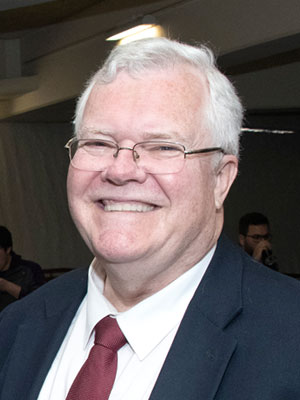
Tim Hallman
“It is rare to have had the opportunity be part of something as phenomenally successful as the RHIC experience—a scientific adventure in which the expertise and hard work of thousands of scientists and engineers around the world, the visionary leadership of giants like Satoshi Ozaki and T.D. Lee, and the support and treasure from peoples all over the globe came together in a single fantastic moment to jolt humankind into a new understanding of the physical world. RHIC afforded me and many others that opportunity. I am privileged to have been a small part of it, and I am inspired to work with all my heart to ensure that future generations of scientists and engineers have that same marvelous opportunity.” — Timothy Hallman, Associate Director for Nuclear Physics, DOE Office of Science

Berndt Mueller
“From the first iconic collision event recorded by STAR to today’s precision beam energy scan, RHIC has changed our understanding of the nature of nuclear matter at the highest temperature and densities. It enabled the discovery of the “perfect fluid” properties of the quark-gluon plasma, showed the gluons contribute to the spin of the proton, and seeded theoretical insights ranging from string theory to exotic quantum materials, all made possible by astonishing advances in accelerator science and technology. In short, RHIC far exceeded the high expectations of those who conceived and built this unique collider facility.” — Berndt Mueller, Associate Laboratory Director for Nuclear and Particle Physics
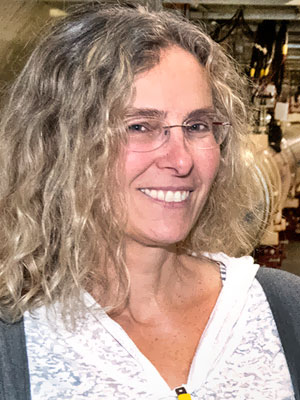
Angelika Drees
“I remember those first shifts operating RHIC in 1999 and 2000, when we at first had more time without beam than with it. Protecting the superconducting elements was the highest priority! 1999 was such an exciting year. My daughter was just born in January, and here I was a member of the team commissioning the newest particle accelerator of the world—a task for which I had come to Brookhaven from CERN in 1997. Steering the beams into collision for the first time in 2000 by painstakingly slowly scanning one beam across the other in steps of tens of micrometers at a time—a method now streamlined and fully automated—is still in use today to calibrate each run’s delivered luminosity (an indicator of potential collision rates). I cannot wait to be a part of the EIC commissioning team, to bring our future flagship accelerator online.” — Angelika Drees, group leader and physicist in the Collider-Accelerator Department and EIC task force leader
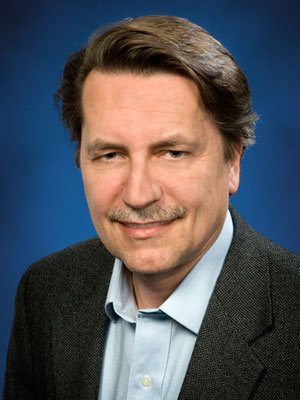
Thomas Roser
“The performance improvements in all aspects of RHIC over the last 20 years have been absolutely spectacular, a result of an excellent design and the continuous development and implementation of improvements and upgrades. Among the many ‘firsts’ at RHIC, the one that stands out is the addition of the completely new capability of colliding polarized protons at RHIC, which enabled the proton spin research program. This was not part of the original RHIC design and ventured into the uncharted territory of high-energy polarized beams. The achievement of accelerating highly polarized proton beams at RHIC also laid the groundwork for the polarized Electron-Ion Collider.” — Thomas Roser, Chair of Brookhaven’s Collider-Accelerator Department

Doon Gibbs
“I joined Brookhaven’s physics department in 1983 to do experiments at the still-under-construction National Synchrotron Light Source (NSLS). Just weeks after I arrived, ISABELLE, which was to be the next big facility in high-energy physics, was canceled. It was a traumatic event and to me the Lab seemed at loose ends. Soon after, the idea for RHIC came along. Flash forward to one of the most intense and exciting feelings I’ve ever had as a scientist: the day first collisions were achieved at RHIC. It was a monumental achievement in accelerator science and promised a new understanding of nuclear matter. The whole Lab came together with energy and exhilaration! And all of us were part of it. It was a fantastic week, followed by 20 years of stunning successes—and is a testament to the collaborative science Brookhaven can achieve. I remembered that feeling when we turned on NSLS-II and also at the announcement that the Electron-Ion Collider would be built at Brookhaven Lab. I look forward to the next decades of achievement, which will come from all of us working together. I still feel lucky just to be here.” — Doon Gibbs, Director, Brookhaven National Laboratory
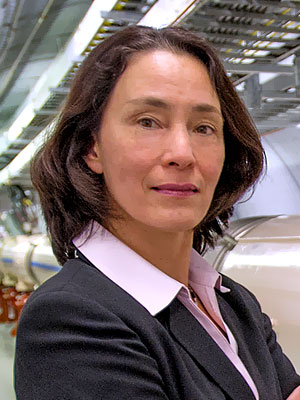
Michiko Minty
“Being a part of the RHIC success story to date has been an incredible experience. The continuous development of innovative and novel technologies and their application in accelerator operations is the result of cross-disciplinary research that draws on the expertise of Brookhaven Lab’s dedicated engineering and technical support staff. The successful fast turn-around from concept to realization of major technological advances creates a dynamic, vibrant and rewarding work environment. We are fortunate to be able to continue developing world-class accelerators with the design and construction of the future Electron-Ion Collider.” —Michiko Minty, Associate Division Head, Accelerator Division

Lee Hammons
“I had just begun my work as a RHIC operator in the Main Control Room around the time that beams were first circulated in RHIC. It was a wonderful opportunity to work directly with some of the people who had designed and built RHIC, and to be part of the tremendous excitement and great challenges that went along with this new machine. It seemed as if each day, there was some new problem, some new lesson that we learned about how to make this machine work, and some new opportunity to stretch the boundaries of the facility. It was a great way to begin a career at the Laboratory. Over the past 20 years, I’ve been inspired by how the accelerator complex has been fine-tuned to simultaneously run experiments at RHIC and two connected facilities that use its particle beams to study space radiation and produce medical isotopes.” — Lee Hammons, Nuclear and Particle Physics Directorate Chief Operating Officer

Elke Aschenauer
“I did not have the pleasure to be a member of the RHIC community from the start, but the last 10 years have been great fun to see all the new results in Cold Quantum Chromodynamics (QCD) materializing. Examples include the first clear signs that gluons contribute to the spin of the proton and that the sea quarks have significant polarization, and recently all the results on the transverse momentum structure of the proton. These novel results in combination with the knowledge gained working at the world’s only polarized collider give me the foundation for the future discoveries we will make at the EIC.” — Elke-Caroline Aschenauer, Cold QCD Group Leader, RHIC
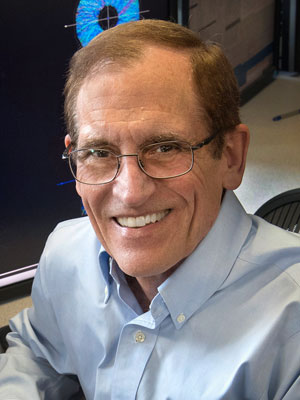
Robert Tribble
“Carl Gagliardi and I joined the STAR collaboration in 2002 as faculty members in the Physics Department at Texas A&M University. We were working on an effort being led by Steve Vigdor (then at Indiana University) to develop broader coverage at STAR for polarized proton collisions. Our interest was sparked by the development of polarized proton beams at RHIC with excellent spin alignment capabilities, which opened the door for probing the internal spin structure of the proton. Successfully completing the hardware upgrades and moving to data taking and analysis has led to major contributions from both STAR and PHENIX toward understanding the gluon component of the proton spin. Since coming to Brookhaven, I have continued to work with RHIC and its two collaborations in what has been a truly remarkable success story of discovery.” — Robert Tribble, Deputy Director for Science and Technology, Brookhaven Lab
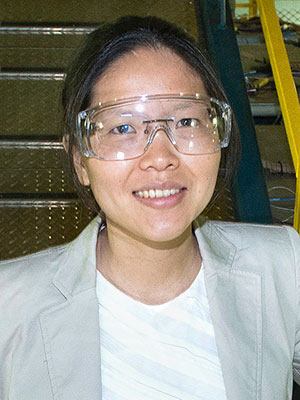
Lijuan Ruan
“Twenty years ago, when I was a PhD student at the University of Science and Technology of China, I got a chance to help develop a Multi-gap Resistive Plate Chamber (MRPC) with Professor Hongfang Chen’s research group. At that time, we were talking about using MRPC technology to build a Time-of-Flight detector at STAR. We built 12 MRPC modules, put those in a prototype tray, and installed it at STAR in 2002. It worked beautifully. This was the first time that MRPC technology was used successfully in a collider experiment. What impresses me most is that RHIC has always been a highly competitive discovery machine, even in these days, continually pushing the limits of technology. For me, this is truly amazing.” — Lijuan Ruan, STAR group leader and STAR Collaboration co-spokesperson
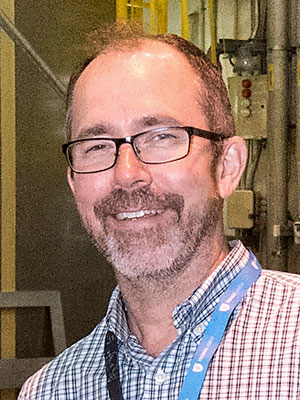
Dave Morrison
“When I was a graduate student at MIT in the 1990s, working on my dissertation at the Alternating Gradient Synchrotron (AGS) and looking forward to the start of RHIC, the question on the table was whether one could really show that the quark-gluon plasma existed. It's amazing how much deeper the questions in the field have become since then, getting to the connections between our most fundamental physical theories and the hugely complex phenomena we observe in heavy-ion collisions. We are always asking what the next steps should be. That's where sPHENIX, a transformation of RHIC’s original PHENIX detector, comes in. sPHENIX has a strong collaboration, audacious goals, and a bevy of advances in detector and electronic technology that will exploit the fantastic performance of RHIC to help answer those questions.” — Dave Morrison, former PHENIX Collaboration co-spokesperson and sPHENIX Collaboration co-spokesperson
What are your RHIC memories?
What are your memories from the time RHIC was starting up or high points from the past 20 years of RHIC operations? Share them on social media using the hashtag #RHIC20, and use that hashtag to follow the collection we share from the Lab’s Twitter account throughout RHIC’s 20th anniversary year. If you don’t have your own social media feeds, send your memories to us and we’ll consider adding them to the Lab’s social media posts.
Brookhaven National Laboratory is supported by the U.S. Department of Energy’s Office of Science. The Office of Science is the single largest supporter of basic research in the physical sciences in the United States and is working to address some of the most pressing challenges of our time. For more information, visit https://www.energy.gov/science/
Follow @BrookhavenLab on Twitter or find us on Facebook
2020-17221 | INT/EXT | Newsroom










